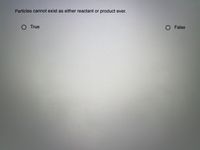
Chemistry
10th Edition
ISBN: 9781305957404
Author: Steven S. Zumdahl, Susan A. Zumdahl, Donald J. DeCoste
Publisher: Cengage Learning
expand_more
expand_more
format_list_bulleted
Question

Transcribed Image Text:Particles cannot exist as either reactant or product ever.
O True
O False
Expert Solution
This question has been solved!
Explore an expertly crafted, step-by-step solution for a thorough understanding of key concepts.
This is a popular solution
Trending nowThis is a popular solution!
Step by stepSolved in 2 steps

Knowledge Booster
Learn more about
Need a deep-dive on the concept behind this application? Look no further. Learn more about this topic, chemistry and related others by exploring similar questions and additional content below.Similar questions
- Consider the following chemical reaction HCl (aq) + HgNO3 (aq) à Hg2Cl2 (s) + HNO3 (aq) If 20.0 grams of HCl is mixed with 30.0 grams of HgNO3 Determine the excess reactant The amount of the solid precipitate that was recovered equals to .................. grams , if the percentage yield from this reaction was determined to be 78.4%. Write the net ionic equation for the chemical reaction Determine the type of this chemical reactionarrow_forward1) The explosive RDX has the chemical formula C3H6NO6. Balance the following combustion reaction for RDX. C3H6N606(s) _CO(g) + H₂O(g) + N2(g) 2) Based on the above reaction, would you expect RDX to produce a lot of smoke when it is burned?arrow_forwardBalance the following chemical equation. Note that a empty blank space will be interpreted as "1." ___N2H4 (g) + ___N2O4 (g) --> ___N2 (g) + ___H2O (g)arrow_forward
- [Tutorial: Limiting reactant stoichiometry] This question will walk you through the steps of calculating the mass of products produced based on your determination of the limiting reactant. b) Step 2a: Use dimensional analysis to determine the theoretical yield of the product. Calculate the theoretical yield in grams Al₂O₃ from the complete reaction of 64.7 grams Al according to the following balanced chemical equation: 2 Al(s) + Fe₂O₃(s) → Al₂O₃(s) + 2 Fe(s) c) Calculate the theoretical yield in grams Al₂O₃ from the complete reaction of 201 grams Fe₂O₃ according to the following balanced chemical equation: 2 Al(s) + Fe₂O₃(s) → Al₂O₃(s) + 2 Fe(s) d) Which of the following substances is the limiting reactant? e) What is the mass in grams of the excess Fe₂O₃ remaining after the partial reaction of 201 g Fe₂O₃ with 64.7 g Al? Give your answer to three significant figures.arrow_forwardWhen aqueous solutions of magnesium chloride (MgCl2) and silver nitrate (AgNO3) are mixed, the products are solid silver chloride and aqueous magnesium nitrate. Write the balanced chemical equation for this reaction. (Include states-of-matter under the given conditions in your answer. Use the lowest possible whole number coefficients.)arrow_forwardWrite a balanced chemical equation based on the following description: liquid C₇H₈O is burned with oxygen gas to produce gaseous carbon dioxide and water vaporarrow_forward
- Relate the model to Chemistry: The balanced chemical reaction for producing water is: 2 H2 + 1 O2 → 2 H2O. Predict which reactant amounts (of the three examples shown below) would get the most water with the least amount of leftovers. Explain how your understanding of Limiting Reactant helped you figure this out.arrow_forwardBalance the following equation. ___N2H4(g) + ___H2O2(g) → ___N2(g) + ___H2O(g)arrow_forwardWrite a balanced chemical equation based on the following description: the reaction of gaseous C_{5}*H_{4} with oxygen gas produces gaseous carbon dioxide and water vaporarrow_forward
- Balance the following chemical reaction. Enter the sum of the balanced coefficients as your answer. Assign "blank" coefficients a value of 1. ammonia + oxygen gas -→ nitrogen monoride + waterarrow_forwardThe starting materials in a chemical reaction are called your "initial products". True False If the number of each type of atom on one side of the arrow differs from the number on the other side, the equation is still considered balance. True False Stoichiometry is the qualitative study of reactants and products in a chemical reaction. True Falsearrow_forwardSee photoarrow_forward
arrow_back_ios
SEE MORE QUESTIONS
arrow_forward_ios
Recommended textbooks for you
 ChemistryChemistryISBN:9781305957404Author:Steven S. Zumdahl, Susan A. Zumdahl, Donald J. DeCostePublisher:Cengage Learning
ChemistryChemistryISBN:9781305957404Author:Steven S. Zumdahl, Susan A. Zumdahl, Donald J. DeCostePublisher:Cengage Learning ChemistryChemistryISBN:9781259911156Author:Raymond Chang Dr., Jason Overby ProfessorPublisher:McGraw-Hill Education
ChemistryChemistryISBN:9781259911156Author:Raymond Chang Dr., Jason Overby ProfessorPublisher:McGraw-Hill Education Principles of Instrumental AnalysisChemistryISBN:9781305577213Author:Douglas A. Skoog, F. James Holler, Stanley R. CrouchPublisher:Cengage Learning
Principles of Instrumental AnalysisChemistryISBN:9781305577213Author:Douglas A. Skoog, F. James Holler, Stanley R. CrouchPublisher:Cengage Learning Organic ChemistryChemistryISBN:9780078021558Author:Janice Gorzynski Smith Dr.Publisher:McGraw-Hill Education
Organic ChemistryChemistryISBN:9780078021558Author:Janice Gorzynski Smith Dr.Publisher:McGraw-Hill Education Chemistry: Principles and ReactionsChemistryISBN:9781305079373Author:William L. Masterton, Cecile N. HurleyPublisher:Cengage Learning
Chemistry: Principles and ReactionsChemistryISBN:9781305079373Author:William L. Masterton, Cecile N. HurleyPublisher:Cengage Learning Elementary Principles of Chemical Processes, Bind...ChemistryISBN:9781118431221Author:Richard M. Felder, Ronald W. Rousseau, Lisa G. BullardPublisher:WILEY
Elementary Principles of Chemical Processes, Bind...ChemistryISBN:9781118431221Author:Richard M. Felder, Ronald W. Rousseau, Lisa G. BullardPublisher:WILEY

Chemistry
Chemistry
ISBN:9781305957404
Author:Steven S. Zumdahl, Susan A. Zumdahl, Donald J. DeCoste
Publisher:Cengage Learning

Chemistry
Chemistry
ISBN:9781259911156
Author:Raymond Chang Dr., Jason Overby Professor
Publisher:McGraw-Hill Education

Principles of Instrumental Analysis
Chemistry
ISBN:9781305577213
Author:Douglas A. Skoog, F. James Holler, Stanley R. Crouch
Publisher:Cengage Learning

Organic Chemistry
Chemistry
ISBN:9780078021558
Author:Janice Gorzynski Smith Dr.
Publisher:McGraw-Hill Education

Chemistry: Principles and Reactions
Chemistry
ISBN:9781305079373
Author:William L. Masterton, Cecile N. Hurley
Publisher:Cengage Learning

Elementary Principles of Chemical Processes, Bind...
Chemistry
ISBN:9781118431221
Author:Richard M. Felder, Ronald W. Rousseau, Lisa G. Bullard
Publisher:WILEY